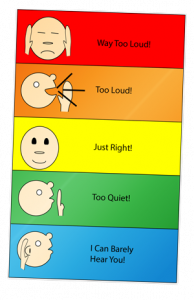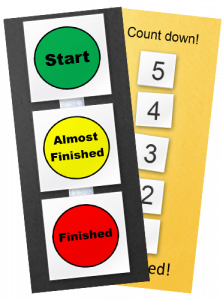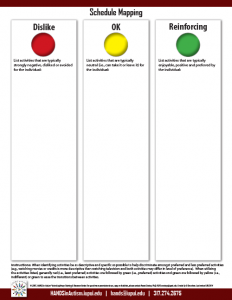3 Building the Environment
Physical and Visual Structure
The foundation of a solid learning environment is the structure in place to help students understand what is going on throughout the day. Having some structure to where different activities are going to take place can help children/students begin to understand what is going to take place in a particular area. For example, if students know that “in this place I am going to do work with my teacher” and “in this place I am going to play by myself”, they can mentally prepare for the day and the activity they are about to complete. Having the physical spaces set up can help prepare students’ expectations for what is going to happen.
 Additionally, having visual cues can give children/students permanent reminders. These may include area labels so students know what each space is used for or expectations and/or rules of various areas. Displaying these in terms of what children/students are supposed to be doing can help to ensure everyone knows what is expected.
Additionally, having visual cues can give children/students permanent reminders. These may include area labels so students know what each space is used for or expectations and/or rules of various areas. Displaying these in terms of what children/students are supposed to be doing can help to ensure everyone knows what is expected.
Visual structure can also be used to let students know how long they will be at an activity. While some activities have a natural ending (e.g., completing work, finishing a snack or lunch etc.) other activities do not. These activities need to have some parameters around when they are ending.
Using tools such as a stoplight to let children know when we are starting, almost finished and finished can help them understand that time is passing and the activity will end. A countdown can also be used to help children/students know that something is ending. By letting students know they have 5 more minutes, turns or problems to solve can help them to see that same passage of time.
 Using the countdown to show that visual reminder makes it permanent and helps students to visualize the abstract concept of time. For more information with stoplights and countdowns (including making your own) check out our Stoplight and Countdown How-tos.
Using the countdown to show that visual reminder makes it permanent and helps students to visualize the abstract concept of time. For more information with stoplights and countdowns (including making your own) check out our Stoplight and Countdown How-tos.
While countdowns and stoplights are great to use when you may not know exactly how long you need a student to be in an activity, using a visual timer when you know exactly how long an activity will last is another great way to show time is passing. There are a number of different visual timer apps that you can use with students to help show time is passing. Visual timers are used when we know exactly how long students will be in an activity without a clear end, such as having a 5-minute sensory break before lunch at a designated time.
Schedules and Work Systems
In addition to physical and visual structure, a schedule will help students to prepare for what will be occurring throughout their day. Visual schedules can come in a variety of forms and should fit the needs of the student. Students needing picture supports should have those pictures included in the schedule to help them know what they are to be doing, whereas students who are proficient readers may only need a list with words to tell them the sequence of their day.
 Areas and events on a schedule should match the labeling of the physical structure to allow clarity is what is going on. Length and complexity of the schedule should be tailored to what each student needs. Our Schedules How-to can provide you with more information about schedules.
Areas and events on a schedule should match the labeling of the physical structure to allow clarity is what is going on. Length and complexity of the schedule should be tailored to what each student needs. Our Schedules How-to can provide you with more information about schedules.
For particularly difficult parts of the day, breaking out the schedule into smaller parts can help some students. Using a First, Then board, can help remind students during non-preferred or more difficult tasks that a preferred activity will come after.
Some tips:
- Preferred tasks or activities should not be followed by a non-preferred activity.
- Adding an indifferent task or activity before a non-preferred activity can help make that transition easier.
- Additionally non-preferred activities should be followed by a preferred activity to help make the non-preferred activity more motivating.
First, Then boards can be a great way to use motivation and keep students on track. For more information about making a using first them boards, our First-Then How-to can help provide more information.
Another type of schedule to help students understand what is going on in workspaces is a Work System. A work-system is a schedule related to the work that students will be completing. It tells students how much work they will do in a work space and let them know what materials will be used. Work systems typically stay within the work space (or within a binder that is carried with the student to the work spaces) and is set up for the students before they get to the area. Work systems help students see the natural end to the work once it is finished. For more information about work systems check out our Work System How-to.
Choreography
Just as having a schedule planned out for students ensures they know what is coming next, having a schedule for adults also helps us know what is coming next. Setting up a choreography or master schedule of the day shows everything that is going on throughout the classroom or home space. Adding in adult times such as meetings, breaks and lunches will help guarantee there is adequate support for the activities going on.
For example, if your child needs help setting up technology for a virtual lesson, scheduling someone to be there to help means sessions start on time and with less stress so the child can be more successful. Having the overview of what everyone (adults and all children) are doing will allow you to be as prepared as possible for whatever may come during the day.

